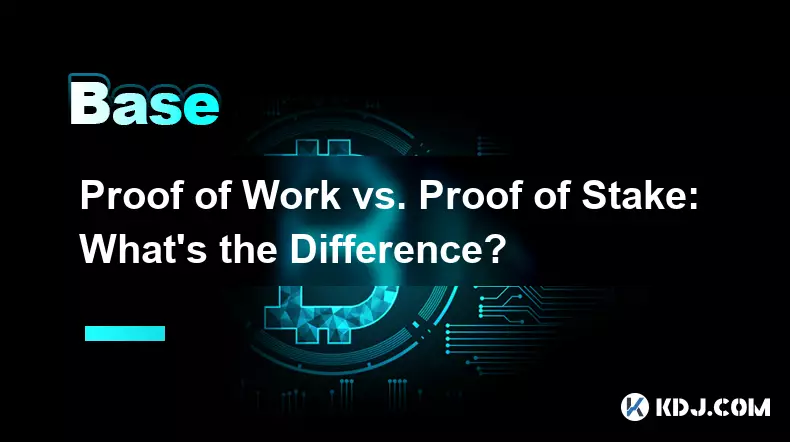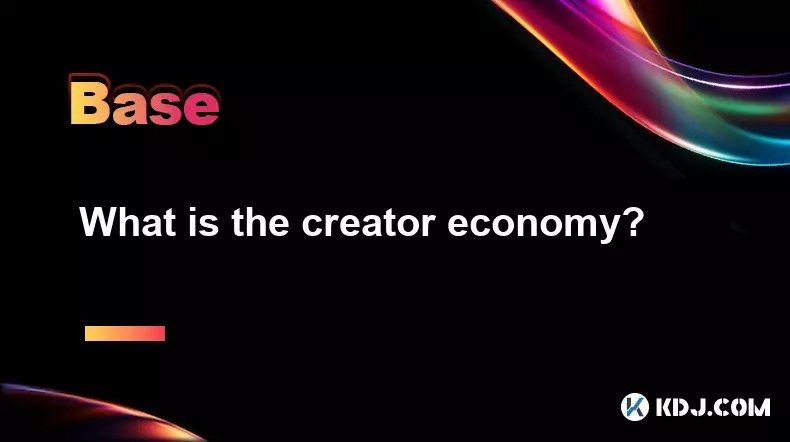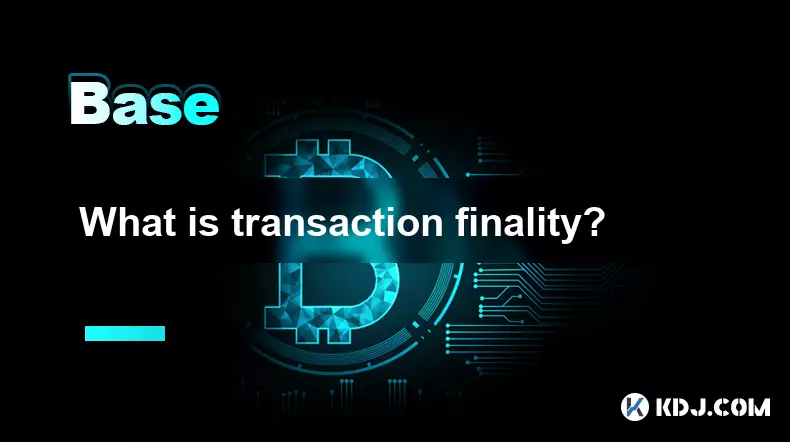-
 bitcoin
bitcoin $116750.837634 USD
1.11% -
 ethereum
ethereum $4515.341020 USD
-0.47% -
 xrp
xrp $3.043113 USD
1.49% -
 tether
tether $1.000476 USD
0.02% -
 bnb
bnb $959.123861 USD
4.03% -
 solana
solana $236.571244 USD
0.47% -
 usd-coin
usd-coin $1.000002 USD
0.00% -
 dogecoin
dogecoin $0.269342 USD
-0.14% -
 tron
tron $0.343000 USD
-0.81% -
 cardano
cardano $0.880538 USD
1.74% -
 hyperliquid
hyperliquid $54.247044 USD
1.00% -
 chainlink
chainlink $23.521588 USD
-0.41% -
 ethena-usde
ethena-usde $1.001241 USD
0.01% -
 sui
sui $3.597422 USD
1.64% -
 avalanche
avalanche $30.081531 USD
1.20%
Proof of Work vs. Proof of Stake: What's the Difference?
Blockchain consensus evolves from energy-heavy Proof of Work to efficient Proof of Stake, balancing security, sustainability, and accessibility in decentralized networks.
Sep 08, 2025 at 08:54 am

Understanding the Core Mechanisms of Blockchain Consensus
1. Proof of Work (PoW) relies on computational power to validate transactions and secure the network. Miners compete to solve complex cryptographic puzzles using high-powered hardware. The first to solve the puzzle gets the right to add a new block to the blockchain and receives a cryptocurrency reward.
2. Proof of Stake (PoS) eliminates the need for energy-intensive mining by selecting validators based on the amount of cryptocurrency they hold and are willing to 'stake' as collateral. Instead of solving puzzles, validators are chosen to create new blocks and confirm transactions according to their stake and other selection methods.
3. In PoW, the probability of earning the block reward depends on how much computing power a miner contributes to the network. This has led to the rise of large mining pools and specialized equipment like ASICs, which centralize mining operations over time.
4. In PoS, the likelihood of being selected to validate a block is proportional to the size of the stake and the length of time it has been held. This reduces the barrier to entry and allows more participants to contribute to network security without expensive hardware.
5. Both systems aim to achieve distributed consensus, but they differ fundamentally in how they incentivize honest behavior and deter malicious actors. In PoW, attackers would need to control more than 50% of the network's computing power, which is prohibitively expensive. In PoS, attackers would need to own more than 50% of the total staked coins, which would make attacking the network economically irrational due to the value of their own stake.
Energy Consumption and Environmental Impact
1. PoW is notorious for its high energy consumption. Networks like Bitcoin require vast amounts of electricity, comparable to the annual usage of small countries. This has sparked criticism from environmental groups and regulators concerned about carbon emissions.
2. The environmental footprint of PoW stems from the continuous operation of mining rigs that perform trillions of calculations per second. Even with renewable energy sources, the sheer scale of energy demand raises sustainability concerns.
3. PoS drastically reduces energy usage because it does not rely on computational competition. Validators run software on regular computers, consuming a fraction of the power required by mining farms.
4. Ethereum’s transition to PoS in 2022, known as 'The Merge,' reduced its energy consumption by over 99%. This shift has positioned PoS as a more sustainable alternative in the eyes of developers and investors.
5. As global pressure mounts for greener technologies, PoS-based blockchains are gaining favor among environmentally conscious projects and users who prioritize long-term ecological responsibility.
Security Models and Economic Incentives
1. In PoW, security is derived from the cost of acquiring and operating mining hardware. An attacker must invest heavily in equipment and electricity, making large-scale attacks financially unfeasible under normal market conditions.
2. PoS ties security directly to the value of the native cryptocurrency. Validators risk losing their staked funds if they attempt to validate fraudulent transactions—a mechanism known as slashing.
3. The economic model of PoS encourages long-term holding and active participation in network governance. Users who stake their coins are more aligned with the health and stability of the blockchain.
4. PoW rewards miners regardless of coin ownership, which can lead to immediate selling pressure as miners offload newly earned coins to cover operational costs. This dynamic can influence price volatility.
5. In PoS systems, validators are typically long-term stakeholders, reducing sell pressure and potentially contributing to more stable market conditions over time.
Decentralization and Accessibility
1. PoW was initially designed to be highly decentralized, allowing anyone with a computer to mine. However, the rise of ASICs and mining pools has concentrated power in the hands of a few large operators, mostly located in regions with cheap electricity.
2. PoS allows for broader participation since users can stake with consumer-grade hardware. Many platforms offer staking-as-a-service or allow delegation to trusted validators, enabling even small holders to earn rewards.
3. Some PoS networks implement measures to prevent centralization, such as limiting the maximum stake per validator or using randomized selection algorithms to ensure fair participation.
4. While PoS improves accessibility, concerns remain about the 'rich-get-richer' effect, where those with larger stakes earn more rewards, potentially increasing wealth concentration over time.
5. Hybrid models and novel consensus mechanisms are being explored to balance decentralization, security, and fairness, reflecting ongoing innovation within the cryptocurrency space.
Frequently Asked Questions
What prevents a PoS validator from validating fraudulent blocks?Validators in PoS systems are required to lock up a certain amount of cryptocurrency as collateral. If they attempt to validate invalid transactions, they face penalties known as slashing, where part or all of their stake is destroyed. This creates a strong economic disincentive against dishonest behavior.
Is Bitcoin still using Proof of Work?Yes, Bitcoin continues to operate on a Proof of Work consensus mechanism. It remains the largest and most secure PoW blockchain, with a vast network of miners contributing computational power to maintain its integrity.
Can a PoW blockchain switch to PoS?Yes, a blockchain can transition from PoW to PoS, though it requires a major network upgrade. Ethereum successfully completed such a transition in 2022. The process involves careful coordination, testing, and community consensus to ensure a smooth migration without compromising security.
Does staking in PoS guarantee profits?Staking rewards are not guaranteed and can vary based on network conditions, the total amount staked, and the specific protocol rules. Additionally, price fluctuations of the staked asset can affect overall returns, and there may be lock-up periods or penalties for early withdrawal.
Disclaimer:info@kdj.com
The information provided is not trading advice. kdj.com does not assume any responsibility for any investments made based on the information provided in this article. Cryptocurrencies are highly volatile and it is highly recommended that you invest with caution after thorough research!
If you believe that the content used on this website infringes your copyright, please contact us immediately (info@kdj.com) and we will delete it promptly.
- PEPE, Cryptocurrency, Investor Moves: Riding the Meme Coin Wave
- 2025-09-17 22:25:14
- Dogecoin, Price Prediction, and Crypto Presales: What's the Hype?
- 2025-09-17 23:25:12
- WLFI, LINK, BlockDAG: Decoding the Hype and the Hope
- 2025-09-17 23:05:14
- DeepSnitch AI Presale: The Crypto Opportunity New Yorkers are Talking About
- 2025-09-17 23:05:14
- Bitcoin ETFs, Institutional Flows, and Real Estate Tokens: A New Era for Crypto?
- 2025-09-17 22:45:12
- BlockDAG's Hardware Rollout vs. ONDO's Price Surge: A Crypto Contrarian's Take
- 2025-09-17 23:10:16
Related knowledge

What is the creator economy?
Sep 10,2025 at 02:54am
Understanding the Creator Economy in the Digital Age1. The creator economy refers to a digital ecosystem where individuals produce content, build audi...

What is social recovery for wallets?
Sep 09,2025 at 09:54am
Understanding Social Recovery in Cryptocurrency Wallets1. Social recovery is a security mechanism designed to help users regain access to their crypto...

What is an RPC node?
Sep 17,2025 at 12:00am
Understanding the Role of RPC Nodes in Blockchain Networks1. An RPC (Remote Procedure Call) node serves as a communication bridge between blockchain u...

What is a blockchain API?
Sep 16,2025 at 05:54pm
Understanding Blockchain APIs1. A blockchain API is a set of protocols and tools that allow software applications to interact with a blockchain networ...

What is a crypto payment gateway?
Sep 14,2025 at 06:36pm
Understanding the Role of a Crypto Payment Gateway1. A crypto payment gateway is a technological solution that enables merchants to accept digital cur...

What is transaction finality?
Sep 16,2025 at 11:19pm
Understanding Transaction Finality in BlockchainTransaction finality refers to the point at which a blockchain transaction becomes irreversible and is...

What is the creator economy?
Sep 10,2025 at 02:54am
Understanding the Creator Economy in the Digital Age1. The creator economy refers to a digital ecosystem where individuals produce content, build audi...

What is social recovery for wallets?
Sep 09,2025 at 09:54am
Understanding Social Recovery in Cryptocurrency Wallets1. Social recovery is a security mechanism designed to help users regain access to their crypto...

What is an RPC node?
Sep 17,2025 at 12:00am
Understanding the Role of RPC Nodes in Blockchain Networks1. An RPC (Remote Procedure Call) node serves as a communication bridge between blockchain u...

What is a blockchain API?
Sep 16,2025 at 05:54pm
Understanding Blockchain APIs1. A blockchain API is a set of protocols and tools that allow software applications to interact with a blockchain networ...

What is a crypto payment gateway?
Sep 14,2025 at 06:36pm
Understanding the Role of a Crypto Payment Gateway1. A crypto payment gateway is a technological solution that enables merchants to accept digital cur...

What is transaction finality?
Sep 16,2025 at 11:19pm
Understanding Transaction Finality in BlockchainTransaction finality refers to the point at which a blockchain transaction becomes irreversible and is...
See all articles

























![[Pycoin] PI Coin -History update progress !! Connection with legal money .. This is crazy / Pycoin mining speed acceleration [Pycoin] PI Coin -History update progress !! Connection with legal money .. This is crazy / Pycoin mining speed acceleration](/uploads/2025/09/17/cryptocurrencies-news/videos/pycoin-pi-coin-history-update-progress-connection-legal-money-crazy-pycoin-mining-speed-acceleration/68cab0e2a7747_image_500_375.webp)















































